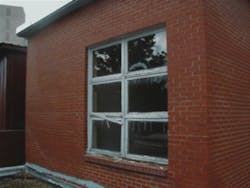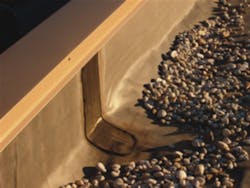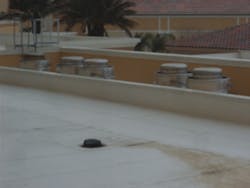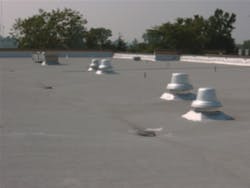The Basics of Roof Maintenance
A roof system is arguably the most vulnerable part of a building's exterior. Ultraviolet radiation, wind, rain, hail, snow, and sleet all affect a roof system's performance.
Performance is based on good design, quality materials, proper installation, and a preventive-maintenance program. Roof maintenance is critical to preventing roof problems and keeping the roof in watertight condition. Early identification and repair of roof problems will help provide a long-lasting roof system.
Building Personnel
Initiating a formal, in-house roof maintenance program is the first step in an overall roof maintenance program. Some aspects of roof maintenance do not need to be performed by roofing professionals, but can be done by the building's maintenance personnel.
The building's personnel can help with some of the most basic maintenance items, such as keeping the roof free of debris. Debris can block the flow of water to the roof drains and cause localized ponding, which can prematurely damage a roof system. Debris may also block the drain lines; in extreme cases, ponding water can lead to roof collapse.
Keeping roof traffic to a minimum should also be a priority for building personnel. Where foot traffic is expected, membrane protection should be provided. Walkway pads or roof pavers will protect the roof's surface (see Figure 1). Building personnel should, at a minimum, walk the roof in the spring and fall, and then provide a written report with observations and/or recommendations to management.
To help understand the complexity of specific roof systems, building owners may want to attend roof system educational seminars. Seminars can be helpful when questions regarding maintenance and roof system replacement arise.
Additionally, educational programs can provide information regarding related building components. Multiple building systems often interface with a roof system and may be the leak's source. Walls may be a source of water leakage that is creating an interior leak at a drain location (see Figure 2). Once under the roof membrane, water is generally free to travel laterally on top of the concrete roof slab or along the flutes in a metal deck, so the leak that appears at a drain may not necessarily be a drain problem at all. HVAC equipment may be the source of what is considered a roof leak. Also, condensation at drain lines and mechanical ductwork can lead to a false reading of a roof leak.
Historical File
Building owners should have and keep up to date a roof system historical file. Maintenance personnel should be familiar with the contents of the roof system's historical file (which should be kept on-site) and the conditions of the warranty so that the proper course of action can be taken when a problem occurs. A detailed history of the roof installation, repairs and changes made, and a roof plan should be included in the historical file. It also should contain the original plans and specifications, warranties, thorough documentation of maintenance and repairs, and, where possible, samples of roof system materials.
The file should be kept with the building when sold and purchased - it provides considerable information for pre-purchase and condition surveys of the property.
Retaining a Contractor
It is important for building owners to retain a professional roofing contractor (preferably the contractor that installed the system) to perform roof maintenance that includes visual inspection and necessary repairs. If building personnel decide to tackle a roof system problem, their actions may void a warranty. In addition, repairs made by an unauthorized contractor will likely void a warranty.
Professional Maintenance
Roof inspections should be performed regularly by trained roofing professionals, preferably on a biannual basis (once in the spring and once in the fall). Early problem detection makes repairs manageable before they become serious. A procedure whereby this is done routinely and recorded in writing should be established.
Inspections and maintenance should also be made after extreme weather events, such as hailstorms, tornadoes, and hurricanes. If damage is detected, it should be repaired as soon as possible.
When a roofing professional is contracted to perform annual maintenance, there are specific items that should be inspected closely because of their susceptibility to damage. These include:
- Flashing. Flashings are critical because a majority of leaks originate at these areas. A detailed inspection of the flashings should be made at locations such as skylights, perimeters, walls, penetrations, equipment curbs, and drains (see Figure 3). Flashings are typically stressed more than the membrane in the roof's field because of thermal movement, possible differential movement, and UV degradation.
- Field. The field of a roof should be inspected for items such as surface wear, lap integrity, and overall degradation. A roofing professional should be able to recognize developing problems and provide proper repair methods.
A maintenance checklist is a useful tool for roofing professionals to use when documenting roof conditions. The checklist should be tailored to each roof's specific requirements. It also can be used as a specification for bid solicitation for future maintenance work.
Other Trades
Rooftop mechanical equipment and penthouses inevitably require maintenance - therefore, other trades will access the roof. A roof system can become the platform and headquarters from which maintenance for the exterior walls is initiated and performed. Window washers, tuckpointers, caulkers, and glazers will often stage their work from the roof. In addition, electrical and mechanical trades will sometimes require roof access to repair heating, ventilation, and air-conditioning equipment. All of this can mean considerable roof traffic, which can quickly cause damage to a roof system if care is not taken.
A written policy may be adopted to help reduce the damage caused by construction and maintenance traffic. This policy may be targeted toward outside contractors and in-house building personnel. The following are examples of general topics that may be included in the policy:
- General access to a roof should be limited or prohibited.
- A log should be developed by the building engineer to record all roof activities, including the personnel involved.
- Building engineers should document rooftop conditions with photographs at the start of a façade or mechanical equipment project. Photographs should also be taken at the end of the job for comparison if there is a dispute about the cause of damage. The before-and-after conditions of all roof system components should also be documented.
- Material stored on the roof membrane should be placed on proper protection boards at all times (see Figure 4).
- Accidental damage to the roof membrane, flashings, or copings should be reported immediately.
- Only professional contractors should be allowed to make repairs to a roof.
- Roof traffic should be kept to a minimum during the winter because cold weather causes the roof membrane to become brittle and more susceptible to damage.
It is important to tailor the policy to include additional topics that cover each building's features. It is the owner's responsibility to manage and coordinate the work performed on the building.
Future Maintenance
It seems that many building owners want a roof system that's inexpensive to install, requires little or no maintenance, and provides trouble-free service for many years; however, it is more realistic to analyze the roof system's cost over its expected service life. Following are some factors that should be considered when performing a life-cycle cost analysis:
- The upfront installation cost should be compared to the expected age at replacement. New, less expensive systems that are so-called "equals" may be risky if they don't have proven track records.
- Paying more for a quality installation should also be averaged against the cost of repairs or early replacement in the future because of a poor installation.
- An initial quality installation will keep a building watertight much longer than a warranty. The type of warranty (e.g. 5-year, 10-year, no-dollar-limit) should also be considered.
- Consider the importance of the building's contents (e.g. sensitive computer systems vs. stored material) and the need for redundancy to prevent leaks to the interior.
- The roofing contractor and the specific roof system's track records should be considered. The watertightness of the roof system is dependent on the material and installation.
All of these items will affect the amount of required maintenance and repair over the roof system's life.
In addition to the previous points, proper details need to be included in the design of the roof system (see Figure 5). Following are a few design considerations that should be included in the roof design to help reduce future repairs:
- Mechanical equipment should be placed on curbs or supports to provide easy access for inspection and maintenance.
- Expansion joints should be designed and installed correctly to help eliminate damage to a roof system by allowing the roof membrane to move with the roof structure.
- Determine if a vapor retarder is needed to help prevent moisture intrusion into and potential condensation in a roof system.
- Positive drainage and appropriate overflow (secondary) drainage should be provided to help prevent ponding and possible collapse if the drains become clogged (see Figure 6).
Warranties
An important point to remember about a manufacturer's roof system warranty is that it probably isn't as comprehensive as owners would like. It is far better to get a quality installation upfront using quality materials than to rely solely on a written document for roof system performance.
Warranties are typically offered by the roofing contractor and the material manufacturer. Roofing contractors offer labor and material warranties for a short period of time (typically 1 to 2 years). Manufacturers' material warranties are for a longer period of time, typically 10 to 20 years or longer, depending on the roof system type. Some steep-slope products have warranties of up to 50 years.
Many material warranties are prorated over the roof system's life. If a roof problem develops after 9 years on a 10-year warranty, the manufacturer may pay only 10 percent of the replacement cost. Further, this 10-percent payment will probably be based on the original cost, not the current cost of replacement.
There are exclusions to every warranty. It is important to read and understand the limitations of a roof system warranty. For manufacturers' warranties, damage to the roof system that is not attributed to a material problem will not typically be covered. For example, if a roof system degrades because of trapped moisture that entered through leaking masonry walls, the manufacturer will not pay for the repairs.
Many warranties have direct or indirect exclusions based on lack of maintenance. If yearly or biannual maintenance is not performed and documented, damage from water intrusion may be excluded if it is determined that the leakage could have been prevented with typical maintenance.
Additionally, roofing contractors may provide maintenance as part of the labor and material warranty. This can remove some of the maintenance responsibility from the owner.
Remember ...
Roofing is a complex science as well as an art. Without a quality roof system that provides years of leak-free service, the building's operations can be hindered. Regular inspections and proper maintenance will help extend the expected service life of a new or existing roof system.
Finally, the money that building owners think is being saved by not performing regular inspections and maintenance will likely be spent in larger quantities when it becomes necessary to repair or prematurely replace the roof system. The cost of a single day of inspection and maintenance is minimal compared to the cost of removing and replacing the entire roof system.
James R. Kirby is associate executive director of technical communications at Rosemont, IL-based National Roofing Contractors Association (www.nrca.net).





